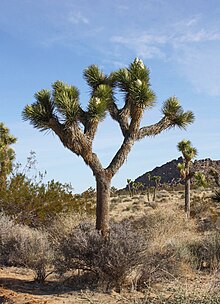Our website is made possible by displaying online advertisements to our visitors.
Please consider supporting us by disabling your ad blocker.
Yucca brevifolia
| Joshua tree | |
|---|---|

| |
| In Joshua Tree National Park, California | |
| Scientific classification | |
| Kingdom: | Plantae |
| Clade: | Tracheophytes |
| Clade: | Angiosperms |
| Clade: | Monocots |
| Order: | Asparagales |
| Family: | Asparagaceae |
| Subfamily: | Agavoideae |
| Genus: | Yucca |
| Species: | Y. brevifolia
|
| Binomial name | |
| Yucca brevifolia | |

| |
| Natural range in the United States | |
| Synonyms[3] | |
| |
Yucca brevifolia (also known as the Joshua tree, yucca palm, tree yucca, and palm tree yucca) is a plant species belonging to the genus Yucca. It is tree-like in habit, which is reflected in its common names.[4][5][6][7]
This monocotyledonous tree is native to the arid Southwestern United States, specifically California, Arizona, Utah, and Nevada, and northwestern Mexico.[8] It is confined mostly to the Mojave Desert between 400 and 1,800 m (1,300 and 5,900 ft) elevation. It thrives in the open grasslands of Queen Valley and Lost Horse Valley in Joshua Tree National Park. Other regions with a large population of the trees can be found northeast of Kingman, Arizona, in Mohave County; and along U.S. 93 just south of the community of Meadview, Arizona a route which has been designated the Joshua Tree Parkway of Arizona. [9] The trees are also abundant in Saddleback Butte State Park 135 kilometres (85 miles) north of Downtown Los Angeles in Los Angeles County's Antelope Valley.[10] The common name, Joshua tree, is derived from Christian iconography.
- ^ Esque, T.C.; DeFalco, L.A.; Hodgson, W.; Salywon, A.; Puente, R.; Clary, K. (2020). "Yucca brevifolia". IUCN Red List of Threatened Species. 2020: e.T117423077A117469962. doi:10.2305/IUCN.UK.2020-3.RLTS.T117423077A117469962.en. Retrieved 18 November 2021.
- ^ "NatureServe Explorer 2.0". explorer.natureserve.org. Retrieved 31 March 2022.
- ^ "Yucca brevifolia". Tropicos.
- ^ Gucker, Corey L. (2009-04-12). "Yucca brevifolia". Fire Effects Information System. U.S. Department of Agriculture, Forest Service, Rocky Mountain Research Station, Fire Sciences Laboratory. Archived from the original on 2009-04-12. Retrieved 2023-07-30.
- ^ "Yucca brevifolia". BioImages. Vanderbilt University. Retrieved 2014-12-06.
- ^ Delange, George; Delange, Audrey. "Joshua Tree, Yucca brevifolia". Arizona Wild Flowers. Delange. Archived from the original on 2006-08-25. Retrieved 2023-07-30.
- ^ Watson, Sereno (1871). "United States Geological Exploration of the Fortieth Parallel". Botany. 5 (464): 496. Bibcode:1878Natur..18..538J. doi:10.1038/018538a0. S2CID 4111357.
- ^ Watson, S (1871). "Yucca brevifolia Engelm". Royal Botanic Gardens, Kew. Botany. Retrieved 2023-07-30.
- ^ Kramer, Kelly Vaughn (3 August 2014). "Joshua Tree Parkway | Wikieup to Wickenburg". Arizona Highways. Arizona Department of Transportation. Archived from the original on 2016-04-01. Retrieved 2023-07-30.
- ^ "Saddleback Butte State Park". California State Parks. Retrieved 2023-06-21.
Previous Page Next Page




